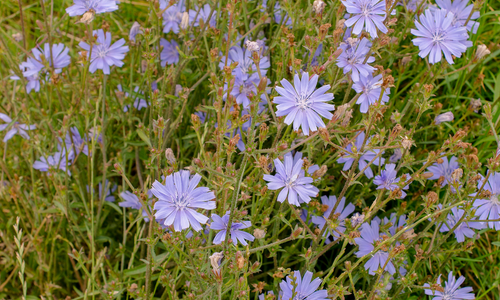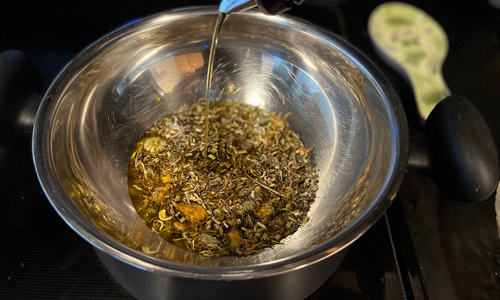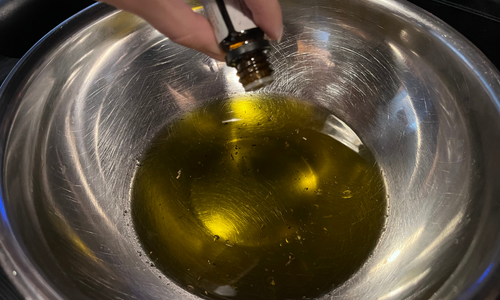Nicks and scratches may not seem like a big deal, but if you find yourself in an emergency scenario without clean water or access to medical services, these small cuts can quickly become dangerous.
One of the things I always make sure to have on me (and in various places around the house) is a first-aid balm that I make with chicory, calendula, and other herbs.
This first-aid balm can be used on just about everything: cuts, scrapes, insect bites, and even rosacea.
It acts as an anti-bacterial, anti-viral, and anti-inflammatory multi-purpose treatment that can accelerate the healing of your wounds, prevent the spread of infection, and soothe your skin.
Making a salve or balm is incredibly easy – you’ll just need an herb-infused oil and some beeswax. If you’ve never made a balm before, you’ll probably be surprised at how easy it is to make one.
And the best part is you can use this recipe with any other herbs too, depending on which medicinal properties you’re most interested in.
First Aid Balm Herbs
In this recipe, we will be using two dried herbs and some essential oils to give this balm its medicinal properties.
Chicory
This European herb with bright blue flowers has been used for hundreds of years for its many medicinal benefits. Consuming chicory has been used to cleanse the liver and improve digestion for at least 5,000 years.
Today, many people drink a chicory root infusion in place of their morning coffee, thanks to a similarity in smell and flavor.
Chicory also has many benefits as a topical. Its stems, leaves, and flowers have powerful anti-inflammatory properties so chicory is a great herb for reducing pain and swelling.
⇒ Similar to Morphine: The Best Natural Painkiller That Grows In Your Backyard
Chicory contains a lot of beta-carotene, which helps speed up the healing process for skin and other tissues. You can grow and dry your own chicory or purchase dried material from an herbal supplier.
Calendula
Often known as marigold, calendula is a must-have in any first-aid balm because it is invaluable for wound healing.
Just like chicory, calendula reduces inflammation. It also kills bacteria, fungi, and viruses, so it can be used for a wide variety of wounds and rashes.
Related: How To Make a Powerful Calendula Extract to Keep in Your Medicine Cabinet (with pictures)
Calendula is also very soothing to the skin and helps with things like diaper rashes, allergic reactions, and insect bites. It is native to North America and is very easy to grow yourself. You can also purchase it at many herbal suppliers.
Making The Herb-Infused Oil
Making a balm or a salve involves two main components: the base and the oil. The base is usually just beeswax or soy wax – something hard that keeps the other ingredients together at room temperature. We will add this at the last step.
In the meantime, we’ll be making the oil using the herbs listed above.
To make the herb-infused oil, you will need:
- Extra-Virgin olive oil
- Double boiler
- Dried herbs (chicory, calendula, and any other dry herbs you want to add)
You can buy dry chicory and calendula from a supplier to save you some time. However, there’s nothing more satisfying than growing your own medicinal herbs for homemade remedies.
⇒ Buy Your Own Chicory And Calendula Seeds Before They Are All Gone
If you don’t have a double boiler, you can make one as I did by filling the bottom of a pot with a few inches of water and placing a bowl over it. As the water heats up and boils, it will gently heat up the contents of the bowl.
A double boiler is important because you never want to overheat your oil – this can make the oil rancid and it can also diminish the medicinal effects of the herbs.
Note: You can use a different oil if you prefer not to use olive oil. Some great options for this balm are jojoba oil, coconut oil, and almond oil.
Directions:
- Place 1 cup of dried herbs in the double boiler and pour in the olive oil so that the herbs are fully submerged.

- Allow the mixture to infuse over heat for at least 3-4 hours until the oil darkens and takes on the scent of the herbs.

- When finished, carefully pour the mixture into a jar through a cheesecloth to strain the oil from the herbal bits. You will be left with a beautiful healing oil!
Making The Chicory And Calendula Balm
To make your herb-infused oil into a balm, you will need to add a base to it. I chose to use organic beeswax for my base, but you can also use soy wax, paraffin wax, or candelilla wax.
For the balm you will need:
- 1 oz of beeswax
- 1 cup of herb-infused oil that you just made
- Double boiler
- Empty jars or tins for the salve
- Essential oils
I am using lavender essential oil and peppermint essential oil. Lavender acts as an anti-fungal and anti-bacterial topical, boosting the medicinal properties of this balm.
Peppermint oil can reduce itching so it’s great for applying to insect bites or scratches that just need to be left alone to properly heal. It can also penetrate deep under the skin and help with muscle and nerve pain. It makes a great addition to the first-aid balm.
Once again you will need a double boiler, so clean out any remaining herbal oil from your double boiler and set everything up.
Directions:
- Pour 1 cup of herb-infused oil into the double-boiler and add 1 oz beeswax.

- Add 8-10 drops of lavender essential oil. (Optional: You can also add a few drops of peppermint oil).

- Allow the mixture to heat up until the beeswax is fully melted and mixed into the oil.
- Pour the mixture into your salve tins.

- Allow to cool for about 1 hour until fully solidified.

This recipe usually fills 2-3 salve tins depending on their sizes. Once the balm is cooled, you can begin using it on any scratches, wounds, and bites.
Just make sure that you wash out your cuts before putting the balm over them. If wounds are deep, apply the balm and cover with bandages to encourage proper healing.

No comments:
Post a Comment